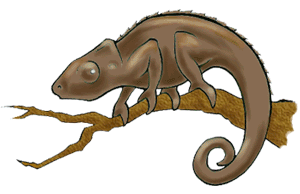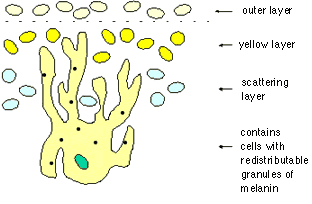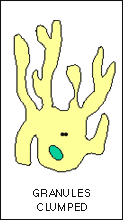How Do Chameleons Change Color?
Chameleons exhibit remarkable optical phenomena. A chameleonís skin can quickly and dramatically change color, its eyes allow it to look in almost all directions without moving its head, and it even has a rudimentary third eye!
More than 100 species of true chameleons exist. They are found in Africa, Madagascar, Spain, southern Europe, Arabia, India, Sri Lanka, and the Seychelles Islands. Several color-changing lizards in the United States, commonly called anoles, are also popularly called chameleons.
The chameleon has a remarkably long, sticky tongue, which darts into the air to catch insects. Its body is unusually shaped, and most chameleons are specially adapted to living in trees. The lizard's long, thin legs raise it from the ground, and its toes are divided into opposable sets of two and three digits that enable it to grasp branches rather than cling to them as with claws. The strong, curled tail is also adapted to grasping. Many chameleons have large domed, or casqued, heads, and males may have as many as three horns, sometimes used for combat.
How Chameleons Change Color
In addition to being responsive to light, chameleons change color when they are frightened and in response to temperature and other environmental changes. Hormones that affect special pigment-bearing cells in the skin cause the color change. Its color does not always change to match its surroundings, however, as is commonly believed.

The changing colors of a chameleonís skin are due mostly to special pigment-containing cells in its skin, although some of the color is due to an effect similar to what causes the daytime sky to be blue. Here is a schematic picture of a chameleonís skin:

The cells of the next layer contain yellow pigment.
Under the layer of yellow-pigmented cells is a layer of cells that contain tiny particles, much smaller than any of the wavelengths in visible light. When light having a mixture of colors strikes these cells, the bluer part of the light is scattered over a wide range of directions, while the redder part of the light is hardly scattered at all and mostly continues on in its original direction. This is the same mechanism that produces the blue of a clear daytime sky, and the red of sunrises and sunsets. The blue color produced by this mechanism is called "Tyndall blue".
Finally, under the layer of light-scattering cells is a layer of cells containing granules of a dark pigment called melanin. These cells are unusual because the granules of melanin can be moved around within the cell. The chameleonís hormones cause the granules of melanin to be either distributed widely throughout the cell or to be gathered together into one small clump near the center of the cell. The cells containing the melanin granules have branches that extend up into the two layers above, as shown in the previous drawing. The picture below illustrates how different amounts of dispersal of the melanin granules changes the optical properties of one of these cells.

Where the melanin granules in the melanin-containing cells are completely contracted, you see primarily the yellow pigment in the chameleonís skin. The blue light from the scattering cells is mixed with red, orange, yellow and green unscattered light reflected by the cells below the scattering layer.
Where the melanin granules are partially dispersed, the melanin-containing cells provide a backing underneath the scattering cells, absorbing the red, orange, yellow and green unscattered light, so that the blue scattered light becomes more noticeable. The color of the chameleonís skin is then determined by the yellow pigmented layer plus the blue scattered light. The chameleonís skin looks tan, green, or dark green, depending on how widely dispersed the melanin granules are.
Where the melanin granules are fully dispersed, the animalís skin looks quite dark, sometimes even black. The Tyndall blue from the scattering layer is then mostly absorbed.
The cells with the moveable melanin granules are the only ones that change when the chameleon changes color. The hormones that control the melanin-containing cells can vary in concentration over the chameleonís body, producing elaborate colored patterns. Some patterns are good camouflage, while others' patterns feature showy stripes or spots in contrasting colors that signal the chameleonís mood. The Chameleon Handbook, by Francois LeBerre and colleagues, contains many remarkable photographs of the colors and patterns of chameleons.
A Chameleonís Eyes
A chameleon can aim its two eyes independently, so that one eye looks ahead while the other looks back, or one looks up while the other looks down. The chameleon can do this because its eyes are on slightly raised turrets on either side of its head, instead of being sunken into protective sockets, as ours are. In certain other respects a chameleonís eyes resemble ours. Since chameleons are active during the daytime, their retinas include cone cells. Different types of cone cell respond differently to light of different colors, so an animal with cone cells in its retina can see colors. (Many types of animals that are active only at night lack cone cells in their retinas, and cannot distinguish colors.)
A Rudimentary Third Eye
A chameleon has a small light-sensitive spot on the top of its head. This "third eye" doesnít form an image, so it is only a rudimentary eye. It is called "the parietal eye", and pages 26-27 in The Chameleon Handbook, by Francois LeBerre, shows where it is located on the chameleonís head. In chameleons, the third eye is covered by scales, but in some other kinds of lizards, it is not covered. The third eye is only sensitive to violet and blue light: it ignores light of longer wavelengths.
Fossils of certain extinct fish, amphibia and reptiles also show the third eye. The pineal gland in the brains of humans and other mammals probably evolved from the third eye. In mammals the pineal gland no longer senses light directly; it gets information about brightness from the other two eyes, and then produces hormones that affect sleepiness and wakefulness, including jet lag.
For More Information
Penelope A. Farrant, Color in Nature, Blandford, London, 1997 and 1999. (Distributed in the US by Sterling Publishing, NewYork.) This is an excellent book, with in-depth explanations of the colors you see around you every day. The material about chameleons in this book is accompanied by interesting discussions of what causes the colors of human hair and skin.
Ian Glynn, An Anatomy of Thought, Oxford University Press, London, 2000. Chapter 8 (The Portals of Perception) in this book gives an unusually clear explanation of the rod and cone cells in the retina, and of how they stimulate the brain. Glynn describes in detail how the three different types of cone cells in our eyes produce the sensation of various colors. Page 192 talks about the pineal gland and its relation to the "third eye".
Francois LeBerre, with R.D. Bartlett and Patricia Bartlett, The Chameleon Handbook, Barronís, 2000. This picture-filled book is an excellent source of information about chameleons. It even tells you how to obtain them and raise them as pets.
Hazel Rossotti, Color, Princeton University Press, Princeton, New Jersey, 1985.
Contributor: John Hornstein









